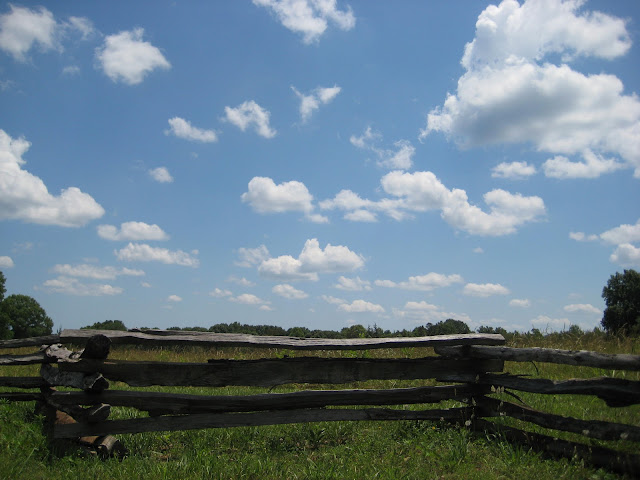June 6-9
Joanna had read about Appomattox in a book called “American Places.” The author, William Zinsser, examines a number of sites with significance to American history. He visits dozens of places and includes chapters on Mount Rushmore, the Normandy cemeteries, and Appomattox.
We’ve been stopping at a number of historic sites in our wanderings. When I mentioned Appomattox as a possible stop on this trip, Joanna was eager to go there.
The locals told us there’s little in the town besides what is now called Appomattox Court House National Historic Park, but it’s well worth a day or so.
This is where the Civil War ended. Lee had withdrawn from Richmond after the fall of its main defense in Petersburg, about 25 miles to the south.
According to the story line at the park, Lee started out with about 25,000 men and wanted to link up with another Confederate army to the south. The Union army shadowed him and kept him from breaking through.
Hunger and fatigue severely reduced his ranks on the hundred-mile trek from Richmond.
The final confrontation came at the village of Appomattox Court House. A U.S. cavalry detachment under George Custer blocked Lee’s way. There were Federal troops at this rear and to his south.
Lee tried to break through the cavalry, which was the weakest link in the chain around him, but ran instead into 15,000 infantry who had come up in support.
He knew it was over. By the time of the surrender, he may have led a force of fewer than 10,000.
The surrender terms—which gave the rebels immediate parole and let them take their mules and horses home—were signed in the parlor of a house owned by a prominent local named McLean.
The house changed hands a few times after the war and at one point was bought by a group of investors, who had it dismantled and planned to ship it to Chicago for the Columbian Exposition. Later they planned instead to move it to Washington, D.C., and charge admission fees.
None of that happened, and the dismantled house stayed in place. The house today has been rebuilt on its original site.
The courthouse for which the village was named burned late in the 19th century, and after that the village declined.
Most of the buildings standing today are originals, but heavily restored. Many were about ready to collapse when the Park Service took them over.
There is a Confederate cemetery, dedicated shortly after the war. Surrounded by magnolias, it contains the graves of 18 Confederate soldiers, each marked with a Stars and Bars flag.
One grave, flying the U.S. Stars and Stripes, contains an unidentified Union soldier, whose remains were found on the battlefield after most of the Union dead had been reburied at a Federal cemetery near Petersburg.
According to the white-washers of the Civil War, the rebels didn’t die to keep slaveholders rich. The official argument is that their “lost cause” was an effort to defend states’ rights.
There is a plaque next to the cemetery that carries the essential flavor of the argument:
“Here on Sunday April 9, 1865, after four years of heroic struggle in defense of principles believed fundamental to the existence of our government, Lee surrendered 9,000 men, the remnant of an army still unconquered in spirit.”
I saw that plaque on my other visit here. It has been edited since then. The attribution line has been removed. There used to be a kind of sign-off in the raised metal letters: United Daughters of the Confederacy.
There aren’t many places in town open for dinner on Monday. That’s why it was doubly delightful that we ended up at Granny Bee’s. When I hear a name like that, it gives me pause, makes me think of that place called Mom’s, where you’re not supposed to eat. (And you know: never play cards with a man named Doc.)
But on the contrary, the food reminded me of a vanishing roadside Virginia, the kind of old-time fare I remember from trips this way 50 years ago.
I haven’t had turnip greens or corn pudding in years. This was Virginia so I had to have the country ham.
Joanna had turnip greens too, along with her steak and green beans.
Green vegetables in the South are usually cooked with some kind of fatty meat, often ham hock. They’re cooked to death and take on a compensating richness from the shortening. It’s comfort food.
We decided to head home from Appomattox, but make one more stop on the way, at James Madison’s plantation, Montpelier, near a town called Orange.
We found the gate of Montpelier easily enough, but found it closed. We had arrived a day too soon. It is open from Wednesday through Sunday.
We did get to see the Montpelier rail station. It was built when the DuPonts owned the Montpelier plantation in the late 19th and early 20th centuries. It has two doors, one labeled “white” and the other “colored.”
They lead to segregated waiting rooms. There is also a tiny post office in the building. The mailbox is out of service, but there seems to be mail in some of the P.O. boxes on the wall.
DuPont had the station built mainly for a weekly commute between Montpelier and his office in Delaware. That train, we read, was the only scheduled stop at the station. Otherwise it was a flag stop for passengers or cargo.
We stayed about 25 miles farther north from the plantation at Holiday Inn Express in Culpeper, Va.
We met a man outside who saw the plate on my car and asked, “What part of New Jersey?”
He said he’d been a policeman in Trenton for 20 years. Now he works for the federal government. He said he is involved in counter-terrorism for the CIA.
I hear colorful stuff like that on the road from time to time. True or false, it’s always fun. This could have been a leg-pull. Or do CIA guys really let it casually drop that they work for the CIA?
But then he started to talk about some serious stuff that had a ring of truth.
The man is black and said he had been encountering a deal of racial prejudice in the short time he had been in the Culpeper area. He had been working in Washington, where there was no problem, but had been assigned here for a few weeks.
He said prejudice is particularly evident for mixed-race couples like him and his wife, and like yourselves, he said to Joanna and me.
I’ve never encountered any open hostility or even unusual rudeness. Oh, maybe a wrinkled nose here and there. But I get that just for wearing a pony tail.
Joanna is aware of people staring at us from time to time, especially at dinner. But hey, we’re pretty colorful when I come to think about it. We look different, sure, and we’ve been places and are having fun.
So the joke goes, Joanna and Harry walk into a bar. The Grill 309 at 309 Main in Culpeper. Everybody takes good care of us. The people are terrific.
So was my burger, made of Virginia black Angus beef. (Avoid the Caesar salad, though. I think the dressing came from a jar.) As usual with a burger, I had a couple of glasses of cabernet sauvignon. This was from Josh, the California label we discovered this past winter on our trip west.
Joanna took the grilled unicorn fish. The menu said it came blackened, but they were able to hold off the Cajun twist. Joanna loves fish and it came with rice. What could be better?
Rather than barrel home from Virginia to Montclair, we broke the trip in half with a stop at another Holiday Inn Express, west of Harrisburg near a village called Linglestown.
I had never been there before but will gladly go again. The downtown is old and charming.
You pass through it on the way to the Greystone Public House, where we had some fried Brussels sprouts to start. They were supposed to come with chili, lime, and honey. We asked the kitchen to hold the chili. Apparently it was already mixed with the lime and honey, so they came dry.
Not bad, but not what we expected. But they went well with the entrees.
Joanna had a “pork tomahawk.” What’s that, we asked. We’ve heard of tomahawk steak, an exercise in wretched excess that can run two or three pounds.
This was more reasonable—a thick-cut pork chop served on the bone, which is always the best way to cook it. Maybe 8 or 10 ounces of meat.
I had a rare steak, which pairs well with sprouts.
Joanna couldn’t quite polish off her pork chop, so I helped her out.
Everything was superb.
Next day was a straight run on familiar roads. Interstates 81 and 78 make a gentle arc across eastern Pennsylvania. Then we take I-287 north through a green belt of Somerset and Morris Counties. Then I-80 and 280 bring us to Eagle Rock in West Orange.
Hell, we could walk home from there. It’s all downhill.
So this is Harry and Joanna signing off until the next time we wander.
Love to all.
h&J












No comments:
Post a Comment